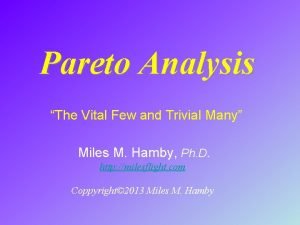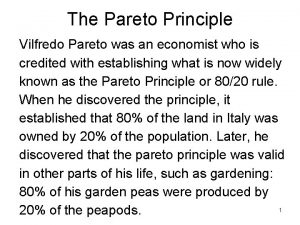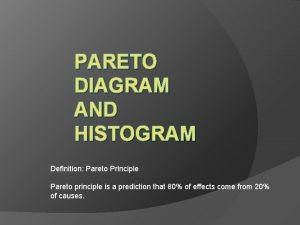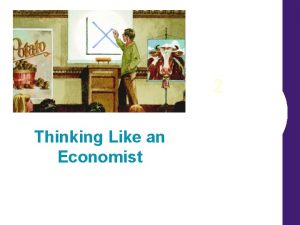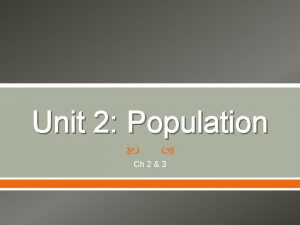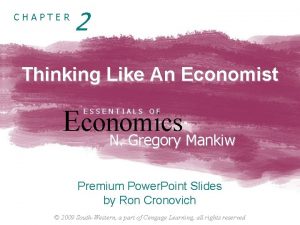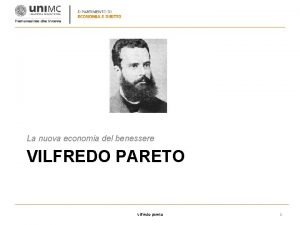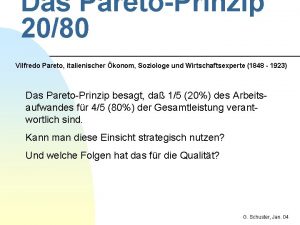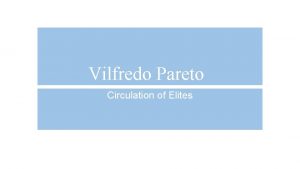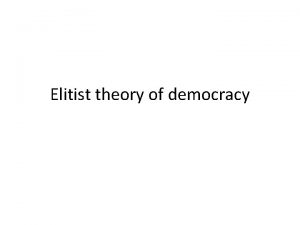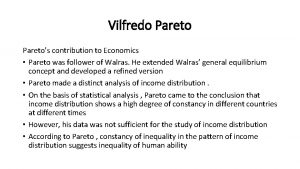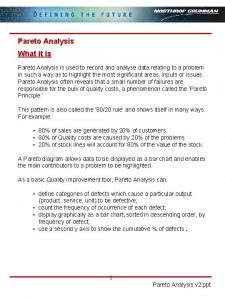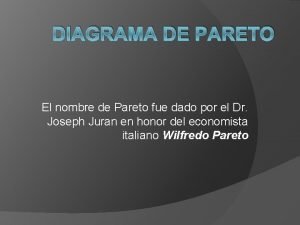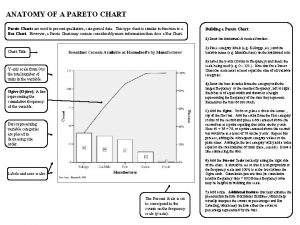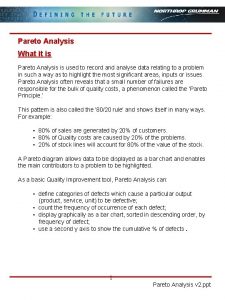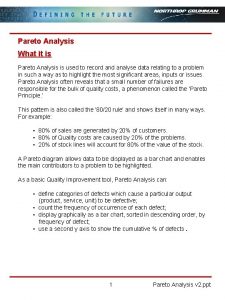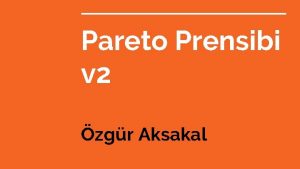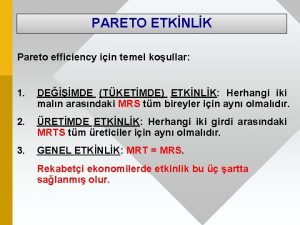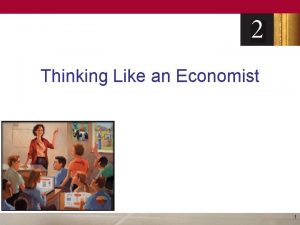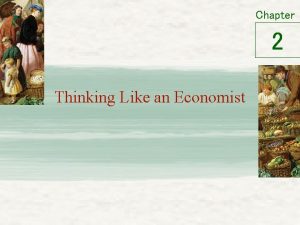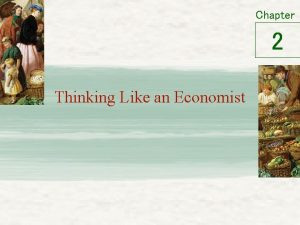The Pareto Principle Vilfredo Pareto was an economist







































- Slides: 39

The Pareto Principle Vilfredo Pareto was an economist who is credited with establishing what is now widely known as the Pareto Principle or 80/20 rule. When he discovered the principle, it established that 80% of the land in Italy was owned by 20% of the population. Later, he discovered that the pareto principle was valid in other parts of his life, such as gardening: 80% of his garden peas were produced by 1 20% of the peapods.

The Pareto Principle Some Sample 80/20 Rule Applications • 80% of process defects arise from 20% of the process issues. • 20% of your sales force produces 80% of your company revenues. • 80% of delays in schedule arise from 20% of the possible causes of the delays. • 80% of customer complaints arise from 20% of your products or services. (The above examples are rough estimates. ) 2

The Pareto Diagram • Graph that ranks data classifications in descending order from left to right • Pareto diagrams are used to identify the most important problems • Advantage: Provide a visual impact of those vital few characteristics that need attention • Resources are then directed to take the necessary corrective action 3

The Pareto Diagram • Helps a team focus on causes that have the greatest impact • Displays the relative importance of problems in a simple visual format • Helps prevent “shifting the problem” where the solution removes some causes but worsens others 4

Constructing a Pareto Diagram Steps: 1. Determine the method of classifying the data: by problem, cause, type of nonconformity, etc 2. Decide if dollars (best), weighted frequency, or frequency is to be used to rank the characteristics 3. Collect data for an appropriate time interval 5

Constructing a Pareto Diagram Steps cont’d: 4. Summarize the data and rank order categories from largest to smallest 5. Compute the cumulative percentage if it is to be used 6. Construct the diagram and find the vital few 6

Percent of components Number of defects Pareto diagram 50% reduction Pareto diagram can be used to identify the degree of severity of quality problems. To eliminate defects and improve the operation, this tool can help us to make decision that which problems should be solved first. 7

Pareto diagram Before improvement After improvement 8

Pareto diagram No. of accidents 9




The Box Plot 13

Comparative Box Plots 14


The Box Plot หาคาขอบเขตลาง fence) จาก (lower inner and outer fence) lower inner fence (L 1): lower outer fence (L 2): upper inner fence (U 1): upper outer fence (U 2): ขอมลทอยระหวาง outlier ขอมลทอยระหวาง และ บน(upper inner and outer Q 1 - 1. 5*IQR Q 1 - 3*IQR Q 3 + 1. 5*IQR Q 3 + 3*IQR L 1 และL 2 หรอระหวาง U 1และ U 2 เรยกวา mild L 1 และL 2 U 1และ U 2 เรยกวา extreme หรอระหวาง outlier L 2 extreme outlier mild outlier L 1 Q 2 U 1 Q 3 U 2 * 1. 5*IQR 16

The Box Plot (Exp 2) Q 1 = Batch % Acetone Insoluble Q 2 = Q 3 = 1 9 IQR = Upper whisker Min (largest value, Q 3+IQR) = Max (smallest value, Q 1 -IQR) = 2 6 24 10 31 22 3 12 11 29 Lower whisker 4 11 12 58 Lower inner fence Q 1 - 1. 5 IQR = Lower outer fence Q 1 - 3 IQR = 5 34 13 15 Upper inner fence Q 3 + 1. 5 IQR = 6 32 14 5 Upper outer fence Q 3 + 3 IQR = low-mild outlier = 7 28 15 17 = 8 19 16 25 low-extreme outlier Up-mild outlier = Up-extreme outlier = 17


The Box Plot (HW 4) The data set of N = 90 ordered observations as shown below 1. Find the dispersion of data using a box plot (i. e. calculate Q 1, Q 2, Q 3, Outlier, find the skewness of the dispersion) 2. Compare the result obtained from (1) with histograms (find mean, SD, skewness of histograms) 30, 171, 184, 201, 212, 250, 265, 270, 272, 289, 305, 306, 322, 336, 346, 351, 370, 390, 404, 409, 411, 436, 437, 439, 441, 444, 448, 451, 453, 470, 482, 487, 494, 495, 499, 503, 514, 521, 522, 527, 548, 550, 559, 560, 572, 574, 578, 585, 592, 607, 616, 618, 621, 629, 637, 638, 640, 656, 668, 707, 709, 719, 737, 739, 752, 758, 766, 792, 794, 802, 818, 830, 832, 843, 858, 860, 869, 918, 925, 953, 991, 1000, 1005, 1068, 1441 19

Cause-and-Effect Diagram • It was developed by Dr. Kaoru Ishikawa in 1943 • Picture composed of lines and symbols designed to represent a meaningful relationship between an effect and its causes • Effect (characteristics that need improvement) on the right and causes on the left 20

Cause-and-Effect Diagram • Enables a team to focus on the content of a problem, not on the history of the problem or differing personal interests of team members • Creates a snapshot of collective knowledge and consensus of a team; builds support for solutions • Focuses the team on causes, not symptoms • Used to investigate either a “bad” effect and to take action to correct the causes or a “good” effect and to learn those causes responsible 21

Cause-and-Effect Diagram Advantages: 1. Analyzing actual conditions for the purpose of product or service quality improvement 2. Elimination of conditions causing nonconforming product or service and customer complaints 3. Standardization of existing and proposed operations 4. Education and training in decision-making 22


Cause-and-Effect Diagram Steps in the construction of a Cause-and-Effect Diagram: 1. Identify the effect or quality problem 2. Determine the major causes 3. Determine all the minor causes. Request a brainstorming session 4. Once the diagram is complete, evaluate it to determine the most likely causes 5. Develop solutions 24

Cause-and-effect diagram Work methods (Man/Methods) Materials Quality characteristic Equipment (Machine) Inspection (Measurement) cause )สงทสงผลกระ ทบตอคณภาพ และเปนสงทตองการ ปรบปรง ( effect 25

Cause-and-effect diagram 2. 6 Worker Size Materials G axle bearing Wobble Inspection Tools 26

Cause-and-effect diagram (dispersion analysis/ cause enumeration) 27

Cause-and-effect diagram (process classification) 28

Cause-and-effect diagram (process classification) Cause-and-effect diagram shows that how scarring occurs during steel tubing process. 29

Good and poor cause-and-effect diagram A B 30

Cause-and-effect diagram with possible causes Is the cause-and-effect diagram good enough for solving the problem? How can we profoundly analyze and quantify the relationship between causes 31 and effects?

Cause-and-effect diagram after further study 32

Scattering diagram The result of investigating the conveyer speed (cause) and the severed length (effect) as shown above 33

Scattering diagram 34

Scattering diagram B A D C E Matching game 35


Control Chart day Static form Dynamic form 37

Control Chart 3 3 day Put the limit lines on the graph so that we can see if the data out of control or not! 38

 Vital few and trivial many
Vital few and trivial many Vilfredo pareto
Vilfredo pareto Lower outer fence
Lower outer fence Pareto chart
Pareto chart правило парето
правило парето The tragedy ofthe commons
The tragedy ofthe commons The young economist's guide to professional etiquette
The young economist's guide to professional etiquette Thinking like an economist chapter 2
Thinking like an economist chapter 2 Economist.com
Economist.com Sample of political cartoon
Sample of political cartoon Tragedy of commons example
Tragedy of commons example Thinking like an economist chapter 1
Thinking like an economist chapter 1 The economist
The economist Thinking like an economist summary
Thinking like an economist summary Economist.com
Economist.com What does the cartoon imply about the open door policy
What does the cartoon imply about the open door policy The tragedy of the commons garrett hardin
The tragedy of the commons garrett hardin Thinking like an economist chapter 2
Thinking like an economist chapter 2 Pangunahing political economist
Pangunahing political economist Thinking like an economist ppt
Thinking like an economist ppt Economist china trade
Economist china trade Thinking like an economist chapter 2
Thinking like an economist chapter 2 Hardin economist
Hardin economist Jane carter labor economist
Jane carter labor economist Chapter 2 thinking like an economist summary
Chapter 2 thinking like an economist summary A wise economist asks a question analysis
A wise economist asks a question analysis Dot
Dot Lời thề hippocrates
Lời thề hippocrates Vẽ hình chiếu đứng bằng cạnh của vật thể
Vẽ hình chiếu đứng bằng cạnh của vật thể Phản ứng thế ankan
Phản ứng thế ankan Môn thể thao bắt đầu bằng chữ f
Môn thể thao bắt đầu bằng chữ f Sự nuôi và dạy con của hươu
Sự nuôi và dạy con của hươu điện thế nghỉ
điện thế nghỉ Một số thể thơ truyền thống
Một số thể thơ truyền thống Thế nào là sự mỏi cơ
Thế nào là sự mỏi cơ Trời xanh đây là của chúng ta thể thơ
Trời xanh đây là của chúng ta thể thơ Chó sói
Chó sói Slidetodoc
Slidetodoc Các số nguyên tố
Các số nguyên tố Thiếu nhi thế giới liên hoan
Thiếu nhi thế giới liên hoan
